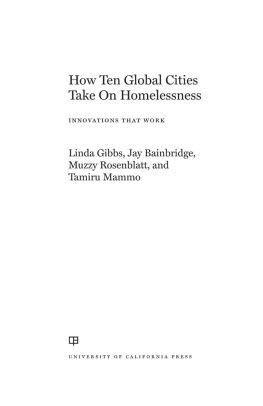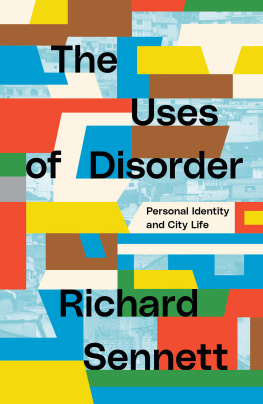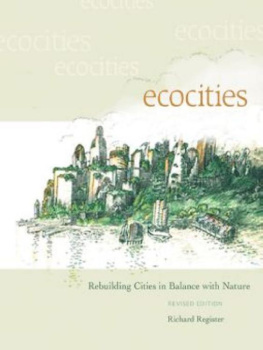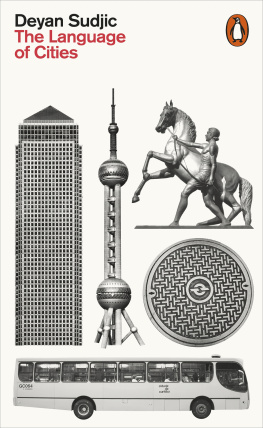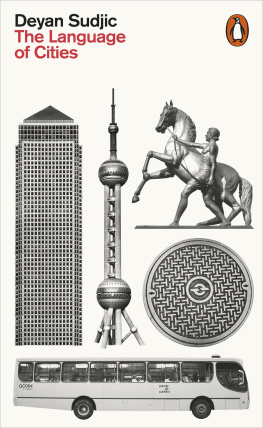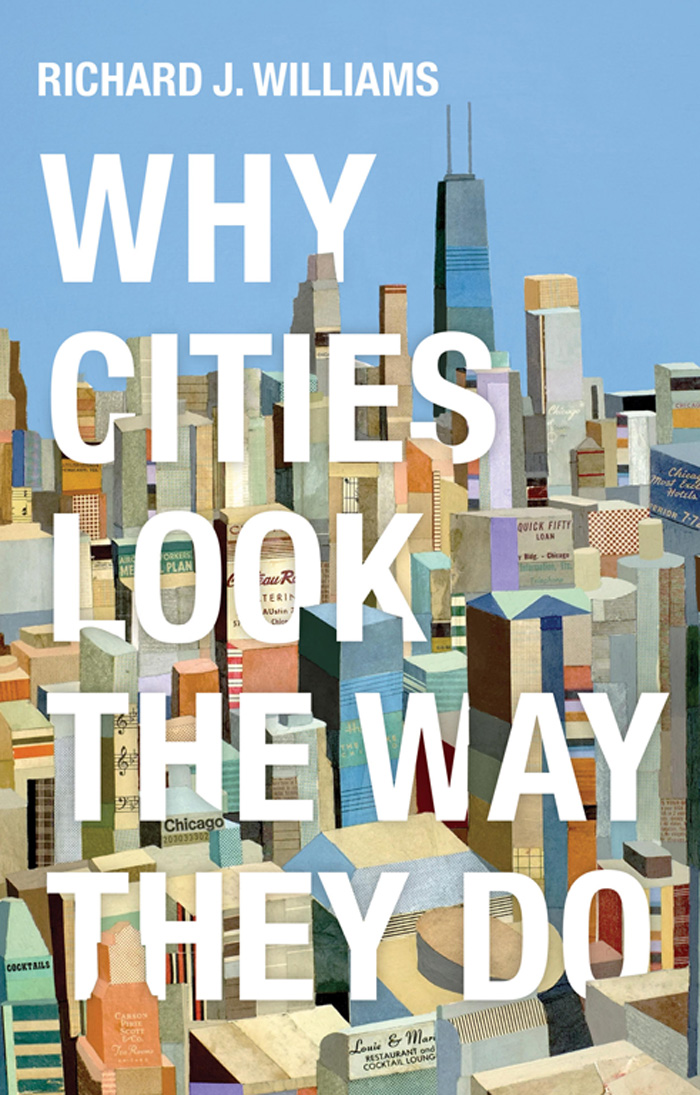Table of Contents
List of figures
- Chapter 1
- Chapter 2
- Chapter 3
- Chapter 4
- Chapter 5
- Chapter 6
- Chapter 7
- Chapter 8
Guide
Pages
Why Cities Look the Way They Do
Richard J. Williams
polity
Copyright Richard J. Williams 2019
The right of Richard J. Williams to be identified as Author of this Work has been asserted in accordance with the UK Copyright, Designs and Patents Act 1988.
First published in 2019 by Polity Press
Polity Press
65 Bridge Street
Cambridge CB2 1UR, UK
Polity Press
101 Station Landing
Suite 300
Medford, MA 02155, USA
All rights reserved. Except for the quotation of short passages for the purpose of criticism and review, no part of this publication may be reproduced, stored in a retrieval system or transmitted, in any form or by any means, electronic, mechanical, photocopying, recording or otherwise, without the prior permission of the publisher.
ISBN-13: 978-0-7456-9180-0
ISBN-13: 978-0-7456-9181-7(pb)
A catalogue record for this book is available from the British Library.
Names: Williams, Richard J., 1967- author.
Title: Why cities look the way they do / Richard J. Williams.
Description: Cambridge, UK ; Medford, MA, USA : Polity Press, [2019] | Includes bibliographical references and index.
Identifiers: LCCN 2018046810 (print) | LCCN 2018060070 (ebook) | ISBN 9780745691848 (Epub) | ISBN 9780745691800 | ISBN 9780745691817 (pb)
Subjects: LCSH: City and town life. | Sociology, Urban. | City planning.
Classification: LCC HT151 (ebook) | LCC HT151 .W58 2019 (print) | DDC 307.76--dc23
LC record available at https://lccn.loc.gov/2018046810
Typeset in 11/13 Sabon
by Toppan Best-set Premedia Limited
Printed and bound in Great Britain by TJ International Limited
The publisher has used its best endeavours to ensure that the URLs for external websites referred to in this book are correct and active at the time of going to press. However, the publisher has no responsibility for the websites and can make no guarantee that a site will remain live or that the content is or will remain appropriate.
Every effort has been made to trace all copyright holders, but if any have been overlooked the publisher will be pleased to include any necessary credits in any subsequent reprint or edition.
For further information on Polity, visit our website: politybooks.com
Figures
All photographs are by Richard J. Williams unless otherwise indicated.
- Singapore, the view from the Jen Orchard complex. The epitome of the global city. (Photo 2018.)
- Visualization for The Pinnacle, development by CBRE in the City of London. (Photo 2016.)
- Canary Wharf, London. The spectacular skyline is entirely a product of thirty years development, dating from the 1986 deregulation of financial services in the City of London. (Photo 2015.)
- Paraispolis favela, So Paulo. High-rise suburb of Morumb in background, as shown in exhibitions at the Venice Biennale of Architecture and Tate Modern. (Photo 2009.)
- Foster and Partners, 30 St Mary Axe, London, completed 2003. (Photo 2018.)
- View from Tate Modern viewing platform looking towards the City of London. (Photo 2016.)
- Singapore central business district. View from Marina Bay Sands Hotel. (Photo 2015.)
- Herzog and de Meuron, Turbine Hall, Tate Modern, London. From a disused power station to the biggest and most visited museum of modern art in the world. (Photo 2016.)
- Praa dos Tres Poderes, Braslia. The political centre of the new capital, inaugurated in 1960. (Photo 2001.)
- Intersection of 405 and 110 Freeways, Los Angeles. The experience of successfully navigating this intersection is one of the highlights of the film ReynerBanhamLovesLosAngeles. Photograph on the approach to LAX. (Photo 2018.)
- Castlefield, Manchester. The remains of the world's first industrial city, now an urban park. (Photo 2017.)
- Daniel Libeskind, Reflections development, Singapore, completed 2011. The logic of the icon. On release, prices for individual apartments started at 2.5 million Singapore dollars. (Photo 2015.)
- Trump Tower, Chicago. SOM architects, completed 2008. The Trump family business is real estate. (Photo 2015.)
- John Portman, Bonaventure Hotel, Los Angeles. The architect as real estate developer. View of block, and pedestrian access to the hotel. (Photo 2010.)
- John Portman, Bonaventure Hotel, Los Angeles. The atrium, looking skywards. (Photo 2010.)
- John Portman, Embarcadero Center, San Francisco. The architect's biggest atrium, and once the world's. (Photo 2014.)
- View of City of London with Rafael Violy's 20 Fenchurch Street on the right. The other buildings are Tower 42 (Seifert and Partners, left) and the Cheesegrater (Rogers Stirk Harbour and Partners, centre). (Photo 2016.)
- Rafael Violy Architects, 20 Fenchurch Street, London. The upper floors attract double the rent of the lower ones so there are more of them. (Photo 2014.)
- Rafael Violy Architects, 432 Park Avenue, New York. (Photograph courtesy Rafael Violy Architects Halkin Mason.)
- The Capitol, Washington, DC. (Photo 2010.)
- Tiananmen Square, Beijing. The world's largest urban square, dating from 1415. The modern enlargement was completed in 1959 to allow rallies of half a million. (Photo 2017.)
- Michael Graves, Portland Building, Portland, Oregon. The first large-scale postmodern monument. (Photo 2017.)
- Terry Farrell, SIS Building, London, completed 1994. (Photo 2018.)
- Kenzo Tange, Tokyo City Hall, completed 1990. Metropolis come to life. (Photo Bohao Zhao, Wikimedia Commons.)
- Miralles Tagliabue EMBT/RMJM, Scottish Parliament, Edinburgh. View of whole Parliament complex from Calton Hill, showing the integration with the buildings of the Old Town. (Photo 2018.)
- Palais de Justice, Brussels, built 186683 to a design by Joseph Poelaert. The word architect allegedly remains an insult in the neighbourhood affected by its building. (Photo 2015.)
- Berlaymont Building, Brussels. The home of the European Commission. Lucien de Vestel (architect), built 19639. Renovations took place in 19952004. (Photo Andersen Pecorone, Wikimedia Commons.)
- On Pier 52, in the same area at the same time, Gordon Matta-Clark made Day'sEnd. (Photo Alvin Baltrop, untitled, c. 1975. Digital image 2018 Museum of Modern Art, New York/Scala, Florence.)
- Cruising Pavilion, Venice Biennale of Architecture, 2018. Installation shot. (Photo Louis de Belle.)
- Canal Street, Manchester. Here, and elsewhere on the street, the C of Canal never survives for long. (Photo 2018.)
- Still from LostinTranslation. Scarlett Johansson contemplates Tokyo from the Park Hyatt Hotel, Shinjuku. (S. Ford Coppola, dir., 2003.)
- Fisher Body Plant, Detroit. Albert Kahn, built 1919. (Photo 2016.)
- Fisher Body Plant, Detroit. Albert Kahn, built 1919. (Photo 2016.)
- Life magazine on loft living, 1970. The magazine was right on trend here, anticipating the wholesale move downtown of commercial galleries in the 1970s.
- Noorderlicht Bar, NDSM, Amsterdam. Steven Gerritsen (architect), built in 2005 using off-the-shelf technology from the agriculture industry. (Photo 2016.)
- Scheepsbouwloods, NDSM, Amsterdam. One of two giant assembly halls on the site. (Photo 2016.)


